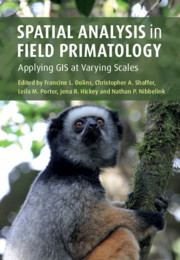Book contents
- Spatial Analysis in Field Primatology
- Spatial Analysis in Field Primatology
- Copyright page
- Dedication
- Contents
- Contributors
- Acknowledgments
- 1 Why Place Matters, and its Use in Primate Behavioral and Ecological Research
- Part I GPS for Primatologists
- Part II GIS Analysis in Fine-Scale Space
- Part III GIS Analysis in Broad-Scale Space
- Introduction
- 15 Modeling Niches and Mapping Distributions
- 16 Does Reduced Habitat Quality or Increased Hunter Access Explain Defaunation of Fragmented Forests?
- 17 Landscape Ecology of Deforestation Processes and Lemur Biogeography in Madagascar
- 18 Quantitative Methods for Primate Biogeography and Macroecology
- 19 GIS and GPS Techniques in an Ethnoprimatological Investigation of St Kitts Green Monkey (Chlorocebus sabaeus) Crop-Foraging Behavior
- 20 Conclusion
- Index
- Plate Section (PDF Only)
- References
16 - Does Reduced Habitat Quality or Increased Hunter Access Explain Defaunation of Fragmented Forests?
Bonobos as a Case Study
from Part III - GIS Analysis in Broad-Scale Space
Published online by Cambridge University Press: 29 January 2021
- Spatial Analysis in Field Primatology
- Spatial Analysis in Field Primatology
- Copyright page
- Dedication
- Contents
- Contributors
- Acknowledgments
- 1 Why Place Matters, and its Use in Primate Behavioral and Ecological Research
- Part I GPS for Primatologists
- Part II GIS Analysis in Fine-Scale Space
- Part III GIS Analysis in Broad-Scale Space
- Introduction
- 15 Modeling Niches and Mapping Distributions
- 16 Does Reduced Habitat Quality or Increased Hunter Access Explain Defaunation of Fragmented Forests?
- 17 Landscape Ecology of Deforestation Processes and Lemur Biogeography in Madagascar
- 18 Quantitative Methods for Primate Biogeography and Macroecology
- 19 GIS and GPS Techniques in an Ethnoprimatological Investigation of St Kitts Green Monkey (Chlorocebus sabaeus) Crop-Foraging Behavior
- 20 Conclusion
- Index
- Plate Section (PDF Only)
- References
Summary
Primatologists require tools to better understand primate habitat use and occurrence at broad spatial scales in order to address the potential consequences of accelerated land use change on many threatened or endangered primate populations. Landscape-level variables derived from remote sensing can contribute to more informed conservation planning decisions, yet need to be grounded in established relationships with local field data. Landscape-level variables necessarily are measured at different scales than GPS-level variables, thereby confounding our understanding of the causal mechanisms that relate them. For example, the mechanism causing empty forest syndrome, a condition in which relatively intact stands of forest are devoid of most fauna, has generally been attributed to local hunting (Fa & Brown 2009; Redford 1992; Wilkie et al. 2011). Wilkie et al. (1992) made a convincing case that forest fragmentation via roads and transects from logging activities exacerbated hunting pressure on forest fauna in the Republic of Congo. Therefore, we (Hickey et al. 2012, 2013) hypothesized that remotely sensed data measuring forest fragmentation and landscape-level proxies of hunter access (distance from agriculture, distance from road, distance from rivers) may correspond to relative hunting pressure for many hunted species because areas near agriculture, roads, and rivers are necessarily near areas of higher human concentration. However, it remains untested whether those landscape metrics actually relate to relative hunting pressure. Approaches using geographic information systems (GIS) and global positioning systems (GPS) are essential to answering such important questions.
- Type
- Chapter
- Information
- Spatial Analysis in Field PrimatologyApplying GIS at Varying Scales, pp. 349 - 364Publisher: Cambridge University PressPrint publication year: 2021



